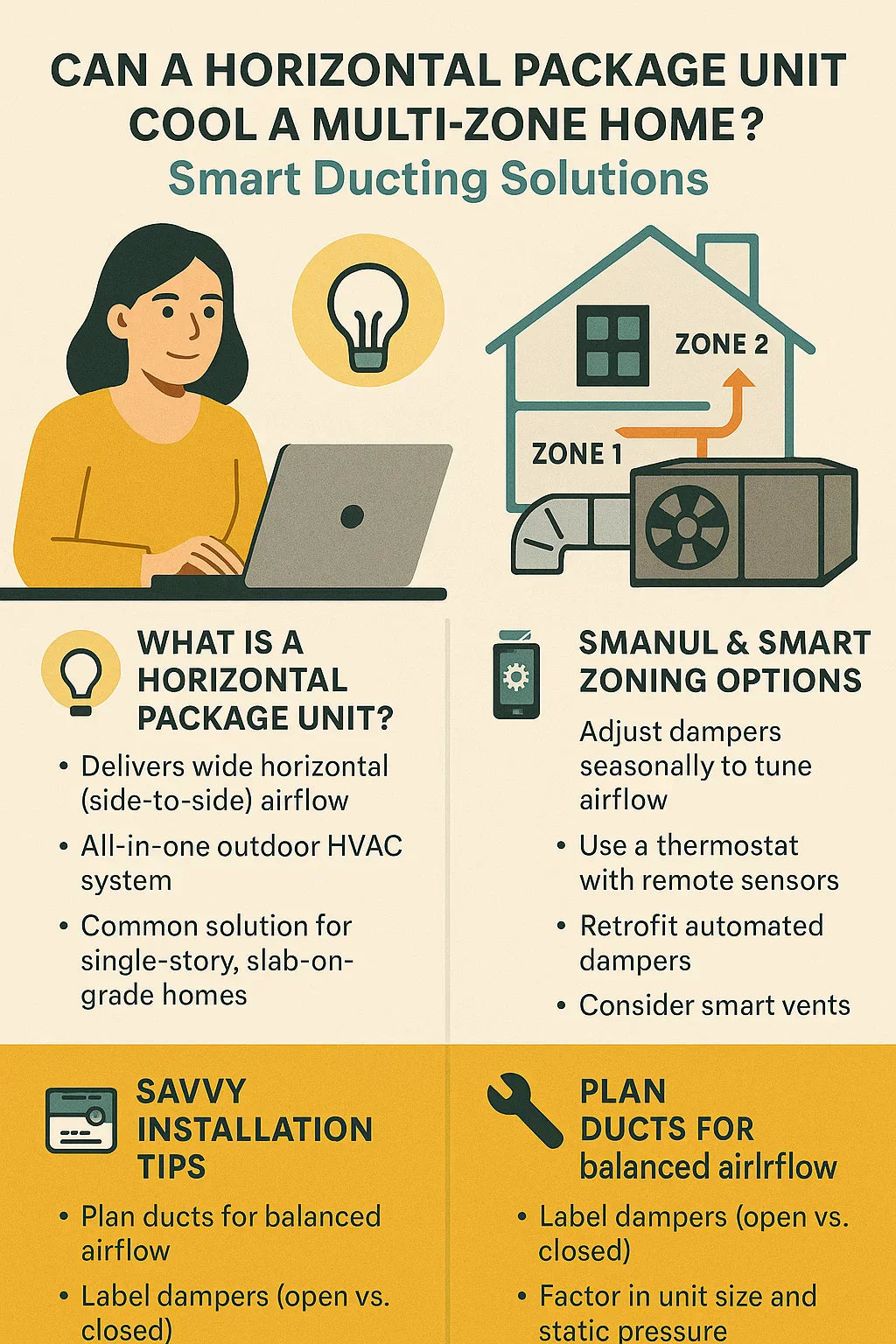If you’re considering a Goodman 2.5 Ton 13.4 SEER2 Self-Contained Horizontal Package Unit for your home, one big question may be: Can this system cool a multi-zone layout effectively?
The answer is yes—with planning. This guide walks Savvy homeowners through airflow design, smart ducting strategies, and zoning enhancements that allow horizontal package units to cool multiple areas comfortably.
🔄 What Is a Horizontal Package Unit?
A horizontal package unit delivers air side-to-side (rather than vertically). All components—compressor, coil, fan—are housed in a single cabinet outside the home.
Best suited for:
-
Slab-on-grade homes
-
Mobile homes
-
Additions or single-story ranch homes
🏠 What Is a Multi-Zone Home?
A "zone" refers to a distinct temperature-controlled area within a home. Examples include:
-
Upstairs vs downstairs
-
Living room vs bedrooms
-
Addition vs main house
Multi-zone setups increase comfort and efficiency, but also require smarter airflow management.
🔗 Zoning overview: HVAC.com Zoning Guide
❓ Can a Horizontal Package Unit Handle Multi-Zone Cooling?
✅ Technically: Yes
-
Horizontal systems can distribute airflow through multiple duct branches.
-
The unit itself isn’t zoned internally, but your ducting layout and controls can achieve zoned effects.
⚠ Limitations:
-
No built-in variable speed or staging (unless upgraded)
-
No built-in zoning control (requires add-ons)
-
Needs careful duct design to prevent pressure imbalance
🔈 Smart Ducting Design for Zoned Comfort
Here’s how to zone your airflow with smart ducting:
✅ Use Balancing Dampers
-
Installed on each branch duct
-
Allow manual adjustment of airflow by room or zone
✅ Distribute Return Air Vents
-
Install a return vent in each zone
-
Balances air pressure and ensures even pull from all areas
✅ Size Ducts Properly
-
Undersized ducts choke airflow
-
Oversized ducts reduce velocity
-
Use Manual D for accurate sizing
🔬 Manual Zoning Techniques
You don’t need advanced tech to get basic zone control:
| Method | How It Helps |
|---|---|
| Manual dampers | Redirect air between branches |
| Register louvers | Fine-tune flow at each vent |
| Adjustable diffusers | Control throw angle and volume |
Example: Open more airflow to the west-facing rooms in the afternoon.
📲 Can You Add Smart Zoning to a Package Unit?
Yes! Horizontal units can support advanced zone controls with a few upgrades:
Options:
-
Smart thermostats + room sensors (e.g., Ecobee, Nest)
-
Motorized dampers for each duct branch
-
Zone control panels to manage multiple thermostats
-
Smart vent systems (Flair, Keen Home)
🔧 Installation Tips for Zoned Ductwork
-
Run separate ducts to each main zone
-
Use flex or rigid ducts, properly insulated
-
Label each duct and damper by room
-
Plan access panels for maintenance
-
Avoid long duct runs or sharp bends
Note: Zoning adds static pressure. Verify the blower can handle the added load.
❌ What to Avoid with DIY Zoning
-
❌ Closing too many vents: Raises static pressure, risks coil freeze
-
❌ Oversizing the unit to cool all zones: Leads to short cycling
-
❌ Poor duct insulation: Loses cooling efficiency
-
❌ One return vent only: Causes pressure imbalance
✉ Pro Tip: Have a Manual J and Manual D calculation done to size ducts and airflow correctly.
📊 Example Layout: 2-Zone Ranch Home
| Zone | Duct Strategy |
| Bedrooms | Separate supply line with manual damper |
| Living/Kitchen | Shared main supply trunk |
| Return Air | One in hallway, one near thermostat |
| Dampers | Labeled for summer/winter balance |
🤝 Final Tips for Savvy Zoning with Package Units
-
Horizontal units can cool multiple zones with the right duct planning
-
Use manual or smart dampers for flexibility
-
Always consider airflow balance and pressure
-
Don’t oversize the system—size the ducts to the zones, not just the house
In the next topic we will read about: Noise, Footprint, and Venting: Will a Goodman Package Unit Work in Your Space?







